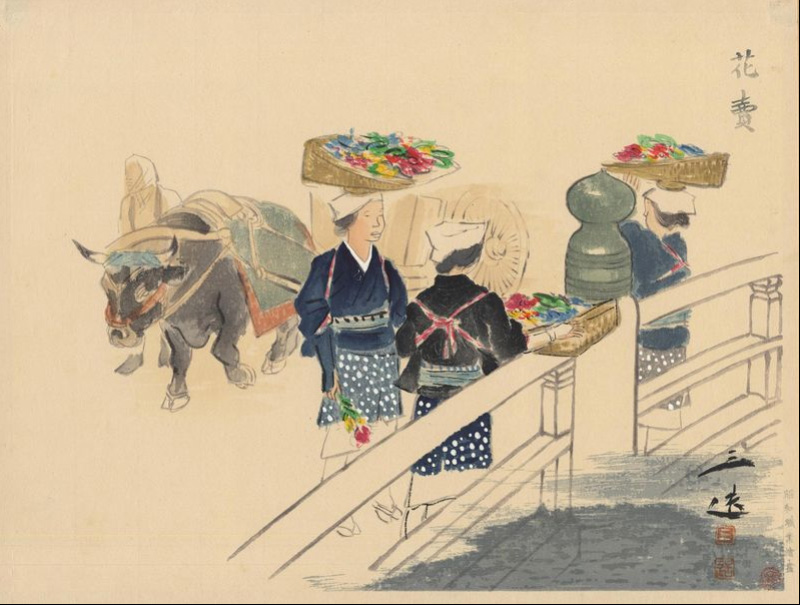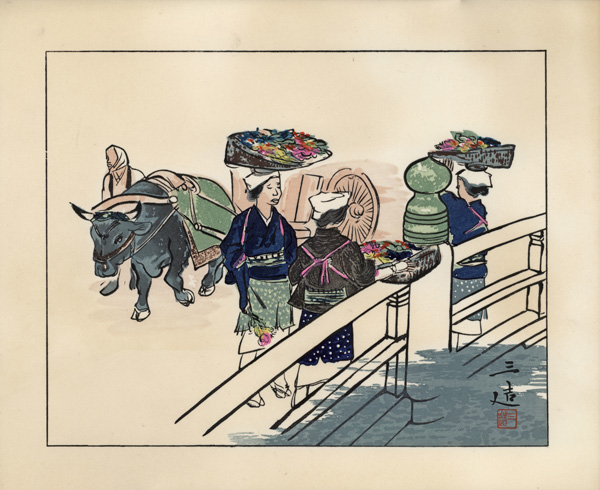About This Print
A second edition by the publisher Kyoto Hangain of the pre-WWII design of flower sellers originally released by Nishinomiya Shoin in June 1941 as print number twenty-one in the series Occupations of Shōwa Japan in Pictures.
Pre and Post-War Commentaries
As described in Memories of Shōwa: Impressions of Working Life by Wada Sanzō, each print was originally released with an explanatory sheet by Wada in Japanese "containing detailed information and personal insights."1 Some of the accompanying commentaries were also translated into English by "Glenn W. Shaw (1881-1961), a writer and teacher who moved to Japan in 1913."2
[First Edition, 1939, published by Nishinomiya Shoin]
Flower VendorsThere are various kinds of flower vendors.It is fashionable for cute girls to sell small bouquets in the station area and for little girls to sell flowers in Tokyo's bars and cafes at night.However, here I have chose to depict the Kyoto flower vendors, because they uphold the reputation of the traditional flower vendors.It seems that even among the women that come from Kyoto's suburbs to sell their flowers, there are differences between those coming from Shirakawa, Yase, or Ohara, and they each have local customs.But in general, they all have in common that they look like typical female workers from former days.They are even identical to women from such places as Izu Ōshima in their headdress, sash and apron, and the face that they carry their wares on their head.Nowadays, the so-called female peddlers from Ohara, too, have considerably updated the old customs. However, we as occasional visitors, do not notice this at all.3
[Second Edition, c. 1954, published by Kyoto Hangain]
OHARAME"Oharame" are the native women who live in the villages of Yase and Ohara about four miles north of Kyoto. They walk about the streets of Kyoto selling flowers, call out "Hana [unread] ka". Don't you want some flowers?They are taking a rest on Sanjo bridge, famous in Kyoto as the end of the Tokaido.The Oharame wears special clothes, differing from those found in other parts of Japan. A piece of towel is very often used as a head-dress as soon [sic] in the picture.The farmer's black ox is a Japanese breed and may have come drawing the wagon from the out skirts of the city. The farmer has decorated the horns of the ox with a strip of blue cloth and has covered the trunk with blankets.Depicted by Sanzo wada [sic] Printed by Kyoto Hanga-In.
1 Memories of Shōwa: Impressions of Working Life by Wada Sanzō, Maureen de Vries and Daphne van der Molen, Nihon no hanga, 2021, p. 14.
2 ibid.
3 ibid. p. 36.
First Edition and Chuban-size Series
As the original publisher Nishinomiya Shoin did (see photo of the first edition on the left below), the post-War publisher Kyoto Hangain (the successor business to Nishinomiya Shoin) reprinted and reissued particular prints in the second edition multiple times, resulting in a number of different print states. In addition, Kyoto Hangain reissued six of the original prints, including Flower Vendors, in a smaller, chuban size (8 3/4 x 10 3/4 in.), edition as shown below. (Also see this collection's print Flower Vendors from the portfolio Japanese Life and Customs A Set of Six Pictures.)
A post WWII re-issue in a smaller (chuban) format by
the publisher Kyoto Hangain. One of six chuban size prints in the series Japanese Life and Customs.
IHL Cat. 1128
About the Series "Occupations of Shōwa Japan in Pictures"
Sources: website of Ross Walker Ohmi Gallery http://www.ohmigallery.com/DB/Artists/Sales/Wada_Sanzo.asp and website of USC Pacific Asian Museum "Exhibition - The Occupations of Shōwa Japan in Pictures: The Woodblock Prints of Wada Sanzō"
Note:
My special thanks to Shinagawa Daiwa, the current owner of Kyoto Hangain, for providing the below information (in a series of emails in July 2014) about Nishinomiya Shoin and Kyoto Hangain, both businesses started by his father Shinagawa Kyoomi. Shinagawa's current website can be accessed at http://www.amy.hi-ho.ne.jp/kyotohangain/
Wada’s major contribution as a woodblock print artist came through his 72 print 3-part series Occupations of Shōwa Japan in Pictures (Shōwa shokugyō e-zukishi), also translated as Occupations of the Shōwa Era in Pictures and Japanese Vocations in Pictures. The three part series was started during the Pacific War (1937-1945) in September 1938, was then interrupted by war shortages in 1943, and was restarted again after the war in January 1954. This series was a labor of love for Wada and he brought together woodblock print printers and carvers in Nishimomiya near Kobe to work on this project.
The war era prints were published by Wada through an old books store, Nishinomiya shoin 西宮書院 run by Shinagawa Kyoomi
品川清臣. Wada
planned a total of 100 designs, with two prints being issued each month. Wada's designs for the prints were rendered in watercolor and the finished prints beautifully captured the look-and-feel of those original watercolors. The series was an immediate hit, but was suspended after 48 prints (issued in two series) in 1943 due to war shortages.
After the war, the series was continued by the same publisher, Shinagawa Kyoomi, who had opened a new business in Kyoto, which he named Kyoto Hangain 京都版画院. (Shingawa's business in Nishinomiya had burned down during WWII.) At first Kyoto Hangain published re-prints of the earlier prints, but they went on to publish a third series of 24 prints, working closely with Wada, titled Continuing Occupations of Shōwa Japan in Pictures between November 1954 and September 1956.1 The post-war prints were popular with the Occupation's "deep-pocketed" military and civilian personnel and the series was "featured in an article of the Tokyo edition of the United States military newspaper Stars and Stripes."2 Shinagawa also published a six print portfolio in the 1950s titled Japanese Life and Customs, consisting of six of the prints from the earlier two series in a reduced chuban size, which is also part of this collection.
Occupations of Shōwa Japan in Pictures has been praised for showing “the complexity of Shōwa society…. capture[ing] the pulse of Japanese life during the tumultuous decades of the 1930s, 1940s and 1950s”3 and condemned as providing a “visual message of subtle or blatant propaganda in support of government-sponsored ideas.”4
It is interesting to see how the commentary, written by the artist, that accompanied each print in the pre-war releases was softened for the post-war re-issues by Kyoto Hangain. All references to soldiers being away from home (as Japanese armies were marching through Asia when the series was originally released) or references to Imperial Japan have been stripped away and the commentary becomes innocent, folk-like and appealing to the post-war occupying forces. (For example, see the prints Women Weavers and Picture Card Show which provide the artist's original commentary and a full transcript of the English text attached to the folders of the post-war re-issued prints.)
1 Keizaburo Yamaguchi gives the publication dates of the post-War series as January 1954 through autumn 1958. (Ukiyo-e Art 16, 1967): 39-42.
2 "Out of the Dark Valley: Japanese Woodblock Prints and War, 1937-1945," Kendall H. Brown,p. 82 appearing in Impressions, The Journal of the Ukiyo-e Society of America, Inc., Number 23, 2001.
3 Pacific Asia Museum website http://www.pacificasiamuseum.org/_on_view/exhibitions/2004/occshowa.aspx
4 Light in Darkness: Women in Japanese Prints of Early Shōwa (1926-1945), Kendall H. Brown, et. al., Fisher Gallery, University of Southern California, 1996, p. 18.
2 "Out of the Dark Valley: Japanese Woodblock Prints and War, 1937-1945," Kendall H. Brown,p. 82 appearing in Impressions, The Journal of the Ukiyo-e Society of America, Inc., Number 23, 2001.
3 Pacific Asia Museum website http://www.pacificasiamuseum.org/_on_view/exhibitions/2004/occshowa.aspx
4 Light in Darkness: Women in Japanese Prints of Early Shōwa (1926-1945), Kendall H. Brown, et. al., Fisher Gallery, University of Southern California, 1996, p. 18.
Print Details
| IHL Catalog | #1003 |
| Title/Description | 花賣 [hana uri] - Flower Vendors [number 21] |
| Series | Occupations of Shōwa Japan in Pictures, Series 1 (also seen translated as "Compendium of Occupations in the Shōwa Era" and "Japanese Vocations in Pictures") Shōwa shokugyō e-zukushi 昭和職業繪盡 (also seen written as 昭和職業絵尽し and 昭和職業繪盡し), daiishū (第一輯) |
| Artist | Wada Sanzō (1883-1967) |
| Signature | 三造 Sanzō |
| Seal |  "Sanzō" - seal of artist "Sanzō" - seal of artist |
| Publication Date | 1950 (originally 1941) |
| Publisher | Kyoto Hangain 京都版画院   版元 京都版画院 摺大野 hanmoto Kyoto Hangain suri [printer] Ono |
| Edition | A second edition of the print first published by Nishinomiya shoin in 1940-41. As originally issued by Nishonimiya shoin this print was the 21st in series 1. It is believed that all the pre-WWII woodblocks for this series were destroyed in Allied air raids in 1945 and that all post-WWII impressions by Kyoto Hangain, the business started by the owner of Nishinomiya shoin, Daiwa Shinagawa, after WWII, were made from re-cut blocks. |
| Carver | |
| Printer | Ōno 大野 [likely Ono Chiyozō] (see publisher's seal above) |
| Impression | excellent |
| Colors | excellent |
| Condition | good - overall toning, most noticeable in the lower right margin; a tear in the paper lower right margin |
| Genre | shin hanga |
| Miscellaneous | originally released by Nishinomiya Shoin as print number 21 in series 1 |
| Format | dai-oban |
| H x W Paper | 11 1/4 x 16 1/4 in. (28.6 x 41.3 cm) |
| H x W Image | |
| Collections This Print | Himeji City Museum of Art Ⅲ-183-21 (dated "1939~1940年"); San Diego Museum of Art 1965.77.v |
| Reference Literature | Light in Darkness: Women in Japanese Prints of Early Shōwa (1926-1945), Kendall H. Brown, et. al., Fisher Gallery, University of Southern California, 1996, p. 83, cat. 96; Memories of Shōwa: Impressions of Working Life by Wada Sanzō, Maureen de Vries and Daphne van der Molen, Nihon no hanga, 2021 |
8/9/2021
12/5/2018




